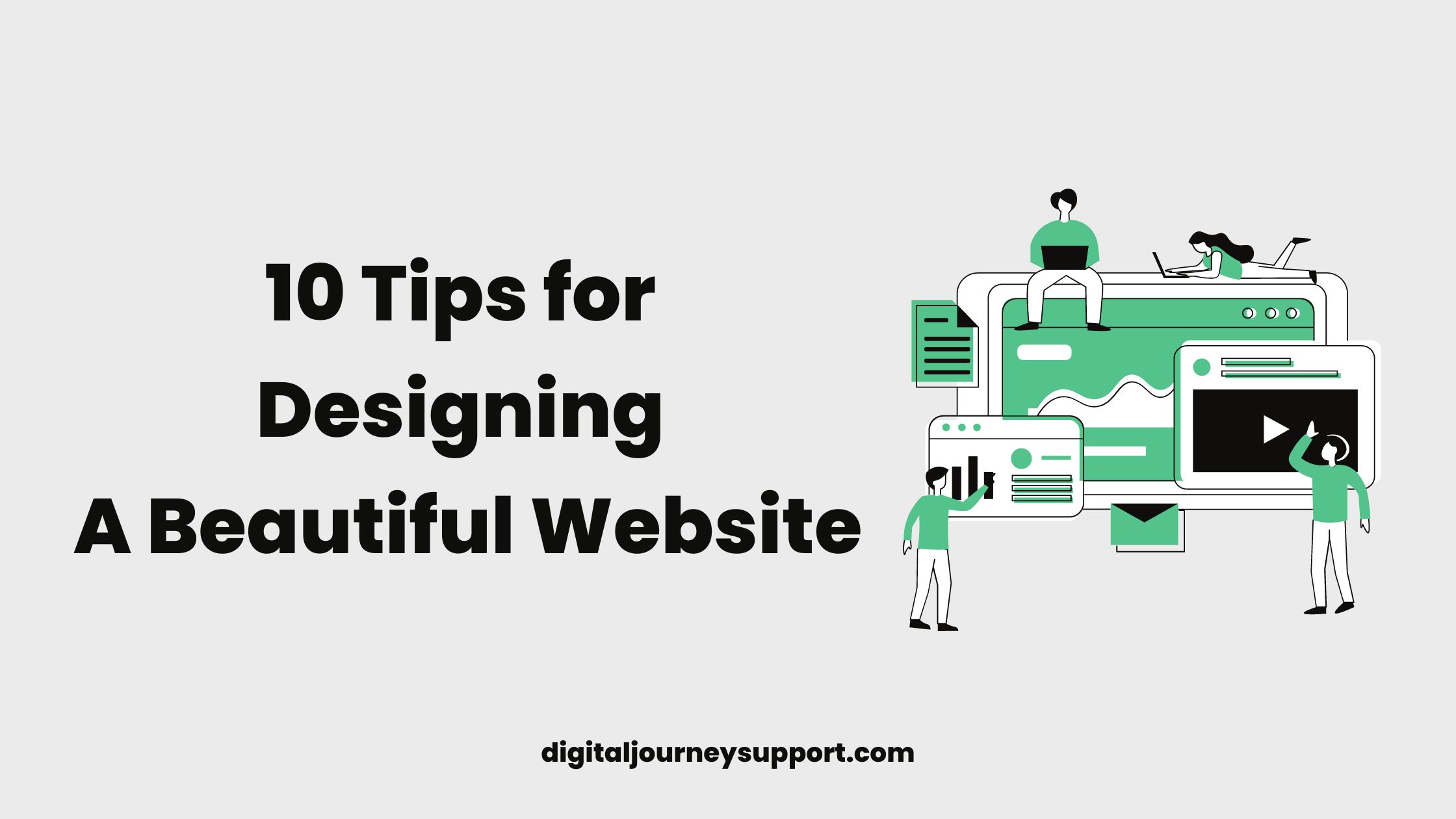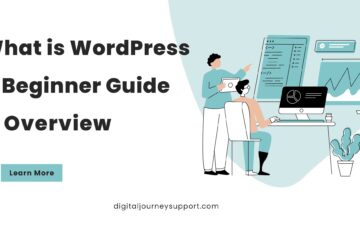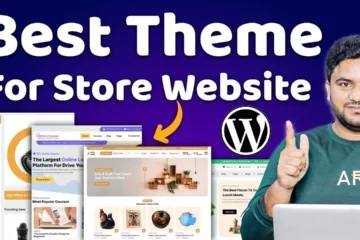Designing a beautiful and user-friendly WordPress website takes more than just a great theme. It’s important to consider various elements such as layout, typography, colour scheme, and navigation to create a website that is both visually appealing and easy to use. In this blog post, we’ll share 10 tips for designing a beautiful and user-friendly WordPress website. Web Designing Tips
Use a clean and simple layout
A clean and simple layout is easy on the eyes and helps visitors focus on the content. Avoid clutter and use white space effectively to guide the user’s eye to the most important elements on the page.
Here are some layout ideas:
- Use a minimalistic design – This type of layout uses a minimal amount of elements and focuses on clean lines, white space, and a neutral color palette. This can create a sense of elegance and sophistication.
- Use a grid-based layout – Grid-based layouts use a series of rows and columns to organize content and create a clean, structured look. This can be a great way to showcase a lot of information in an organized manner.
- Use a single-page layout – A single-page layout can be a great way to create a clean and simple design. This layout style is perfect for creating a minimalistic and modern look.
- Use a card-based layout – A card-based layout is a popular design trend that uses a series of cards to organize and present content cleanly and simply. This layout style is perfect for showcasing a lot of information in a small amount of space.
Recommended Post:
- Use a magazine-style layout – A magazine-style layout can be a great way to create a clean and simple design. This layout style is perfect for showcasing a lot of information in an organized manner.
- Use a scrolling layout – A scrolling layout can be a great way to create a clean and simple design. This layout style is perfect for showcasing a lot of information in an organized manner.
- Use a modular layout – A modular layout is a great way to create a clean and simple design. This layout style is perfect for showcasing a lot of information in an organized manner.
- Use an asymmetrical layout – An asymmetrical layout can be a great way to create a clean and simple design. This layout style is perfect for showcasing a lot of information in an organized manner.
Choose a color scheme that complements your brand
The color scheme of your website should complement your brand and reflect the overall tone of your content. Use a limited color palette to keep the design cohesive and easy on the eyes.
Here are some color scheme ideas:
- Monochromatic color scheme – A monochromatic color scheme uses variations of a single color to create a cohesive and sophisticated look. This type of color scheme is great for creating a calm and relaxing atmosphere.
- Analogous color scheme – An analogous color scheme uses colors that are next to each other on the color wheel. This type of color scheme can create a harmonious and natural look.
- Complementary color scheme – A complementary color scheme uses colors that are opposite each other on the color wheel. This type of color scheme can create a high contrast and dynamic look.
- Triadic color scheme – A triadic color scheme uses colors that are evenly spaced around the color wheel. This type of color scheme can create a balanced and harmonious look.
- Neutral color scheme – A neutral color scheme uses shades of black, white, and grey to create a clean and professional look. This type of color scheme is great for creating a timeless and classic look.
Cheapest WordPress Shared Hosting For You
- Pastel color scheme – A pastel color scheme uses soft and muted colors to create a soothing atmosphere. This type of color scheme is great for creating a light and airy look.
- Bright color scheme – A bright color scheme uses bold and vibrant colors to create a high-energy and dynamic look. This type of color scheme is great for creating a fun and lively atmosphere.
- Dark color scheme – A dark color scheme uses deep and rich colors to create a bold and sophisticated look. This type of color scheme is great for creating a dramatic and mysterious atmosphere.
Many different color scheme ideas can be used to create a beautiful and user-friendly WordPress website. Some popular options include monochromatic, analogous, complementary, triadic, neutral, pastel, bright, and dark color schemes. It’s important to choose a color scheme that complements your brand and the overall tone of your content.
Use typography that is easy to read
The typography of your website should be easy to read and consistent throughout the site. Avoid using too many different fonts and font styles, as this can make the design look cluttered.
Best typography ideas:
- Open Sans – Open Sans is a clean and modern font that is easy to read on any device. It’s versatile and can be used for both body text and headings.
- Lato – Lato is a popular font that is known for its clean and rounded shapes. It’s easy to read on any device and has a versatile style that can be used for both body text and headings.
- Roboto – Roboto is a modern font that is designed to be highly legible on screen. It’s versatile and can be used for both body text and headings.
- Montserrat – Montserrat is a popular font that is known for its clean and elegant design. It’s easy to read on any device and has a versatile style that can be used for both body text and headings.
- Raleway – Raleway is a modern font that is designed to be highly legible on screen. It’s versatile and can be used for both body text and headings.
Recommended Web Hosting For WordPress
- Merriweather – Merriweather is a font that is known for its clean and elegant design. It’s easy to read on any device and has a versatile style that can be used for both body text and headings.
- Playfair Display – Playfair Display is a font that is known for its clean and elegant design. It’s easy to read on any device and has a versatile style that can be used for both body text and headings.
- PT Sans – PT Sans is a font that is known for its clean and elegant design. It’s easy to read on any device and has a versatile style that can be used for both body text and headings.
Clean and intuitive navigation
Navigation is one of the most important elements of a user-friendly website. Make sure your navigation is clear and intuitive, so visitors can easily find what they’re looking for.
How could you set up navigation intuitively?
- Keep it simple: Use a minimalistic approach and limit the number of navigation options to only the most important pages.
- Use clear labels: Use descriptive and clear labels for each navigation option, so users know exactly where they will be taken when they click on a link.
- Use a consistent structure: Use the same structure for your navigation across all pages of your website, so users can easily find what they are looking for.
- Make it prominent: Make sure your navigation is prominently placed, so it is easy for users to find. A common convention is to place the navigation at the top of the page.
- Use dropdown menus: Use dropdown menus to organize sub-pages or groups of pages under one main navigation option.
- Make it responsive: Make sure your navigation is responsive and works seamlessly on different devices and screen sizes.
- Use a search bar: Include a search bar, so users can easily find specific information on your website.
- Use breadcrumb navigation: Use breadcrumb navigation to show users where they are on your website and how they got there.
- Test it: User-test your navigation with real people and make adjustments as needed.
- Keep it updated: Regularly review and update your navigation to ensure it stays intuitive and easy to use.
By following these tips, you can set up a navigation that is intuitive, easy to use and helps users find the information they are looking for quickly and easily.
Optimize images for web
Images can make a big impact on the design of your website, but they can also slow down the page load time. Optimize images for the web by reducing their file size without sacrificing quality.
Best practice for image optimizing
Optimizing images for a website is important for several reasons, including faster page load times, better user experience, and improved search engine optimization (SEO). Here are some best practices for image optimization:
- Use the right file format: JPEG is best for photographs and images with many colors, while PNG is best for images with transparent backgrounds or with few colors such as logos. GIFs are good for simple animations.
- Compress images: Use image compression tools to reduce the file size of images without affecting their quality.
- Resize images: Resize images to the exact size they will be displayed on the website. This will prevent larger images from being loaded and slowing down the page.
- Use alt tags: Use alt tags to describe images for users who use screen readers and for search engines to understand the context of the image.
Recommended Web Hosting For WordPress
- Use proper file names: Use descriptive and relevant file names for images to help with SEO.
- Use a Content Delivery Network (CDN): Use a CDN to distribute images and other static files across multiple servers and reduce the load on your server.
- Optimize images for mobile: Optimize images for different screen sizes and resolutions to ensure they look good on all devices.
- Use lazy loading: Use lazy loading to only load images as they are needed to improve page load times.
- Use WebP images: Use WebP images, they are smaller in size and better optimized than JPEGs and PNGs
By following these best practices, you can optimize images for your website and improve the user experience, page load times, and SEO.
Make sure your website is responsive
With more and more people accessing the internet from mobile devices, it’s important to make sure your website is responsive. This means that the design should adapt to different screen sizes and resolutions.
What means a responsive website?
A responsive website is a website design that adapts to the screen size and resolution of the device it is being viewed on. This means that the layout, images, and text of the website will adjust and reformat to provide an optimal viewing experience on any device, whether it’s a desktop computer, a tablet, or a mobile phone.
Responsive website design is becoming increasingly important as more and more people access the internet using their mobile devices. By ensuring that your website is responsive, you can ensure that your website is accessible and easy to use for all of your visitors, regardless of the device they are using.
In summary, a responsive website is a website design that adapts to different screen sizes and resolutions. It uses flexible grids, images and CSS media queries to adjust the layout of the website depending on the screen size.
How to make your website responsive?
Making a website responsive typically involves using CSS media queries and a flexible grid system. Here are some steps you can take to make your website responsive:
- Use a flexible grid system: A flexible grid system allows you to create a layout that adapts to different screen sizes. This can be done using CSS grid or Flexbox.
- Use CSS media queries: CSS media queries allow you to apply different CSS styles based on the screen size and resolution of the device. This can be used to change the layout, font size, and visibility of elements on your website.
- Optimize images: Make sure images are properly sized, compressed and optimized for different devices and screen sizes.
- Use responsive navigation: Ensure that your navigation menu is also responsive and can be easily used on mobile devices.
- Test on different devices: Test your website on different devices and screen sizes to ensure it looks and works well on all of them.
- Use relative units: Use relative units like percentages for width and height instead of pixels, this will help your website adapt to different screen sizes
- Use responsive font sizes: Use responsive font sizes, it will automatically adjust the font size depending on the screen size.
- Use responsive design frameworks: There are many responsive design frameworks available like Bootstrap, Foundation, Bulma, etc. That can help you create a responsive design quickly and easily.
By following these steps, you can make your website responsive. Ensuring that it looks and works well on all devices and screen sizes. It’s important to note that making a website responsive can be complex, and if you don’t have the technical skills. It’s best to hire a web developer to help you make the necessary changes.
Use calls to action
Calls to action are a great way to encourage visitors to take a desired action, such as signing up for your newsletter or making a purchase. Use clear and prominent calls to action throughout your website.
Make sure your website is easy to update
WordPress is a great platform for building websites, but it’s important to make sure your website is easy to update. This means choosing a theme that is easy to customize and use plugins that are easy to use.
Use social proof
Social proof, such as customer testimonials and reviews, can help to build trust and credibility with visitors. Use social proof throughout your website to build trust and credibility.
Here are some ways social proof can be used for a website:
- Customer reviews: Including customer reviews on your website can help to build trust and credibility, and can influence potential customers to make a purchase.
- Testimonials: Including testimonials from satisfied customers can help to build trust and credibility, and can influence potential customers to take a desired action.
Also
- Social media integration: Integrating social media on your website can help to build trust and credibility and can influence potential customers to take a desired action.
- Trust badges: Including trust badges or seals on your website can help to build trust and credibility and can influence potential customers to make a purchase.
- Several customers: Showing the number of customers that you have can influence potential customers to take a desired action, as it shows that others have found success with your product or service.
- User-generated content: Using user-generated content (UGC) such as photos or videos can be a powerful form of social proof. It shows that real customers are using and enjoying your product and service.
Make sure your website is fast and secure
A fast and secure website is essential for keeping visitors happy and coming back. Use a fast and reliable hosting provider, and make sure your website is secure by keeping WordPress and all plugins and themes up to date.
How to check your website speed?
Website speed is an important factor in providing a good user experience and can also affect your search engine rankings. Here are some ways to check your website speed:
- Google PageSpeed Insights: This is a free tool offered by Google that analyzes your website and provides suggestions for improving its speed and user experience.
- GTmetrix: This tool analyzes your website and provides a report on its performance, including page load time, page size, and the number of requests.
- Pingdom Website Speed Test: This tool analyzes your website and provides a report on its performance, including page load time, page size, and the number of requests.
- WebPageTest: This tool analyzes your website and provides a report on its performance, including page load time, page size, and the number of requests, also you can test your website in different locations and browsers.
- Chrome DevTools: This is a built-in tool in the Chrome browser that allows you to analyze the performance of your website and identify areas for improvement.
- YSlow: This is a browser extension that analyzes your website’s performance and provides suggestions for improvement based on the Yahoo! performance guidelines.
Also Read This: The Ultimate Guide to On-Page SEO
It’s important to keep in mind that website speed can be affected by many factors. Such as the quality of your hosting, the size and several images and other assets, and the complexity of your website’s code. Once you have identified any issues using these tools, you can work to optimize your website and improve its speed.
In conclusion, designing a beautiful and user-friendly WordPress website takes more than just a great theme. It’s important to consider various elements such as layout, typography. Color scheme, and navigation to create a website that is both visually appealing and easy to use.
By following these 10 tips, you can create a website that will help you achieve your goals and give your visitors a great experience.





